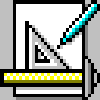|
|

|
|
Design Projects Database
|
|

|
The Remote Explorer
Project Description
Students work in teams of 3 to create a vehicle which will transport
materials between team members, as well as go from each team member to a wall,
where it will pick up an object and return it to the sending team member.
Other rules:
- The vehicle may not be guided by remote control.
- The vehicle must be self-propelled. Students may not assist it except
in preparation (e.g., winding rubber bands, turning switches, etc.)
- The vehicle must be self-contained. It may not drop off parts, etc.
- The vehicle must come in contact with the wall before its return trip.
- Students may not alter the competition site.
- The judge will give the signal to begin. When the last vehicle stops,
that round of competition will end.
- The vehicle may not damage the floor.
- The materials sent between team members may be anything the team chooses.
- Materials must be sent using the vehicle, i.e., they may not be thrown,
rolled, or sent in any other way.
- If a vehicle hits the wall and does not return to the correct explorer,
that explorer may leave his or her area to retrieve the vehicle. If this
happens, the vehicle will not be eligible to receive points for both the
return and successfully retrieving the item.
There are 12 steps the vehicle must perform. They may be done in any order.
Click here for the 12 steps and
suggested grading criteria.
Encourage students to think creatively and use time wisely. Students should
be given 1 to 3 weeks to work on this project.
Materials
- Any appropriate materials up to $10 in cost.
Instructor Time
Most of the advance instructor time in this assignment will come from
helping students with their vehicles. The day vehicles are due, mark the
presentation space on the floor
with tape before the students come in. In a large class, presentations may
take a long time, and there may need to be more than one presentation space
to allow multiple groups to go at once.
Variations
This project is appropriate for the following variations (most are described
in the section how to make design projects
more meaningful):
- How it works
- Individual or group work
- Over the wall
- Reflections
- Redesign
Project Source
Discover"E" National Engineers Week, February 20-26, 1994.
Site maintained by
kerenm@me.umn.edu / last modified July 15, 1998





